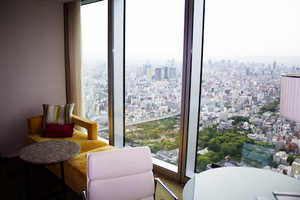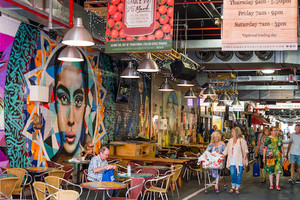
It's widely recognised as Japan's culinary capital, and the intricacies of food in Osaka can be confusing, so we help you sort your tempura from your takoyaki.
Walking through the main drag of Osaka’s Dotonbori district at night, it’s easy to see why it may have inspired Ridley Scott’s 1982 neo-noir classic, Blade Runner. From its noisy main drag choked with tourists, and teenaged fashionistas, to the outlandish shop facades and dazzling neon billboards, it is an overwhelming spectacle.
One of Osaka’s most photographed landmarks, Dotonbori, is famous for many things; the Dotonbori Canal, the mechanised giant pink Kani Doraku crab, the Ebishubashi Bridge (a legendary pick-up spot), and vibrant night life among them.
But it’s also famous for its staggering line-up of restaurants and eateries, capturing the essence of a special term which the Japanese have bestowed upon Osaka. Called “kuidaore”, it roughly means “to ruin oneself by extravagance in food”.
As any local will tell you, Osaka is a “gastronomes'’ town. From unusual local delicacies sold on street stalls, to five-star restaurants where you can blow a week’s wages, there is food at the turn of every street.
The intricacies of Japanese food in general can be confusing, and as first time visitors to Osaka often discover, the city boasts a laundry list of local specialties you won’t find elsewhere in the country.
But the good news is that with a little know-how, it’s easy for anyone to eat ‘till they drop in the well-earned tradition. And it won’t break the bank either - when it comes to food, Osaka is a great place for cheap eats.
Okonomiyaki
This literally translates to “cook what you like,” and is a famous Osakan dish which has spread throughout Japan. It’s a thick, savoury pancake made from eggs and whatever else you like: chicken, pork, beef, octopus, green onions, or cabbage. Okonomiyaki is cooked at the table, often by diners themselves, and it’s served with a rich, brown sauce, and fish flakes, and sprinkled with dried seaweed powder. There are many okonomiyaki restaurants in Osaka from cheap to expensive, but one of the best value is Okonomiyaki Yukari, Sonezaki, Umeda which has prices starting from around 890 JPY, or A$8.
Takoyaki
If you pass a street stall selling something resembling cooked ping-pong balls, these are actually an Osakan delicacy. Balls of fried dough stuffed with octopus, takoyaki are served with soy sauce and dried fish flakes - and they taste much better than they sound! Although takoyaki stalls are found all over town, one of the most famous is Otakoya on Dotonbori, where it costs just 300 JPY, or just under A$3, for six pieces.
Conveyor Belt Sushi
This unique style of sushi dining, called kai-ten, was invented by Yoshaki Shiraishi, who got the idea after watching beer bottles on a conveyor belt in an Asahi brewery. He opened his first restaurant in Osaka 1958, and his empire quickly grew to more than 240 across the country. Oshi sushi is an Osakan speciality made of vingegared rice pressed into a mold and topped with marinated fish, and the place to try it is where the conveyor belt craze began - Mawaru Genroku Sushi, Ajiro in Higashi-osaka City. It costs from 120 JPY a plate, or just over A$1.
Osaka Udon
At the heart of Osaka cuisine are udon - soft, thick white noodles made from wheat, which are often served in a broth, and make for a quick and hearty meal. Dotonbori Imai in Chuo-ku is a popular haunt for local udon lovers, and its famous shippoku udon is a fresh, light soup using fresh ingredients and costs around JPY 1,260, or around A$12. For a wider choice of noodle dishes, a collection of well-known noodle joints converge on the 7th floor “hometown noodle hall of fame” food theme park at Namba Parks in Chuo-ku.
Ikayaki
This is simply grilled squid, but what makes it unique is that it’s a speciality of the Hanshin Department store in Umeda, and costs the same price of the cheapest ticket on the Hanshin railway. Even though it’s climbed from an original price of 10 JPY to around 126 JPY, this local delicacy still manages to draw long lines of tourists.
Gyoza
Food theme parks are popular in Japan, and in Osaka there’s one dedicated to the little Japanese dumplings called gyoza. They may not be that unusual in themselves, but eating them at the Gyoza Stadium in Nanja-town is. It has 10 shops selected from around Japan that are furnished to resemble Osaka during the 1940s, and offer a wide variety of gyoza fillings at very cheap prices. Admission into the park is 300 JPY, or just under A$3 for adults.
Yakiniku
This is a type of barbecued meat, particularly popular in Osaka, and regarded by locals as food which gives you stamina. It came to Japan through the Korean peninsula to Osaka first, and as a result, the city boasts some of the most authentic Yakiniku in the country. Tsuruhashi in east Osaka is famous as Japan’s largest Mecca of Yakiniku barbecue, and has a long line-up of yakiniku barbecue restaurants. One to try is Tsuruichi Original Store, which offers beef ribs starting from JPY 1,680, or A$15.
Kuromon
This isn’t a food, but a food market where amateurs rub elbows with professional chefs. Stretching for several blocks in Nipponbashi, the market dubbed “earth’s pantry” is an Osakan culinary landmark, and like the restaurants of Dotonbori truly embodies the city’s “eat ‘till you drop” culture. Aside from window shopping mouth-watering and unique ingredients, it’s also a great place to pause for a quick lunch or snack.
Other Japanese Delicacies
Tonkatsu - pork cutlets, usually served with shredded cabbage and rice and topped with a rich brown sauce.
Tempura - fish or vegetables deep fried in a light, seasoned batter.
Sukiyaki - thin slices of beef and vegetables in a sweet sauce.
Shabu-shabu - wafer thin slices of beef and vegetables cooked in a hot pot at your table.
Chanko-nabe - a huge stew cooked at the table which was inspired by the hearty appetites of sumo wrestlers.
Fugu - the Japanese blowfish, and a dangerous delicacy which requires a licence to cook.
Naniwa curry - a dry curry topped with a raw egg.
Did You Know?
In Japan, it’s considered highly rude to stand chopsticks upright in rice.
Ramen noodles, which are made from egg, are actually Chinese - traditional Japanese noodles are made from rice.
Rice is considered the most important ingredient in sushi. Only short grain rice which is first soaked, then boiled, simmered, left to stand, and finally cooled by a fan is used to make it.
The Japanese fast food chain, Yoshinoya, was made famous by a dish called gyudon - it’s a high salt, high fat dish of shaved beef and onions, soup poured over rice.
If you ever get invited by a local to an izakaya, it’s a working class Japanese pub. They are often great places for cheap eats, and are known for their lively and friendly atmosphere.
Another Japanese name for tuna is “sea chicken”.
Sushi dates back to at least the second century A.D. in China, starting out as a method of preserving fish.
Ever seen a statue of a cat with a raised paw in a Japanese restaurant and wondered why it’s there? Called a maneki neko, it’s a lucky cat which is believed to attract customers and prosperity.
When drinking hot soup in Japan, slurping is actually a sign of good appetite, and perfectly acceptable behaviour!
Tipping is not expected or encouraged in Japan, even in restaurants, and the locals will often be embarrassed if you try to do it - even in good faith.
For the latest exchange rate on the Yen, visit our partners at XE.com
- By:
- Joanna Hall













